Effect of nitrogen and phosphorous on growth of China aster [Callistephus chinensis (L.) Nees]
Bạn đang xem bản rút gọn của tài liệu. Xem và tải ngay bản đầy đủ của tài liệu tại đây (230.95 KB, 7 trang )
Int.J.Curr.Microbiol.App.Sci (2018) 7(10): 2991-2997
International Journal of Current Microbiology and Applied Sciences
ISSN: 2319-7706 Volume 7 Number 10 (2018)
Journal homepage:
Original Research Article
/>
Effect of Nitrogen and Phosphorous on Growth of China Aster
[Callistephus chinensis (L.) Nees]
Ashish S. Ghormade1*, B.P. Sharma1, Sourabh Garg2 and O.P. Kantwa3
1
2
Department of Floriculture, Dr. YSP UHF, Nauni – Solan, India
Division of Horticulture, Rajasthan Agricultural Research Institute,
Durgapura – Jaipur, India
3
Department of horticulture, SHUATS, Allahabad, UP, India
*Corresponding author
ABSTRACT
Keywords
China aster
[Callistephus
chinensis (L.) Nees.],
Callistephus hortensis
Article Info
Accepted:
20 September 2018
Available Online:
10 October 2018
The present investigations were undertaken at experimental farm of department of
Floriculture and Landscaping, Dr. Y.S. Parmar University of Horticulture and Forestry,
Nauni, Solan (H.P.) during the years 2012-2013. The China aster cv. ‘Kamini’ was
selected for conducting the investigations. The experiment was laid out in RBD (Factorial)
with 20 treatments and 3 replications. Tallest plant (83.32 cm) obtained with a combined
application of 30 g N/m2 and 25 g P2O5/m2 (N2P3) that proved to be at par with N2P1, N2P2
and N4P3 whereas minimum plant height (46.42 cm) recorded in plants without nitrogen
and phosphorus dose (N0P0). A combined dose of nitrogen and phosphorus significantly
improved the plant spread. Maximum plant spread (76.00 cm) found in those plants with a
combined dose of 30 g N/m2 and 25 g P2O5/m2 (N2P3) and proved to be significantly
higher over all other treatments. Maximum number of branches per plant (7.01) recorded
with 30 g N/m2 (N2) that proved superior over other treatments including control (N0).
Largest leaf area (21.72 cm2) found with a combined application of 30 g N/m2 and 25 g
P2O5/m2 (N2P3) and it proved to be at par with N 3P1. However, minimum leaf area (9.82
cm2) recorded in plants supplied with 40 g N/m2 and 25 g P2O5/m2 (N4P3).
Introduction
China aster [Callistephus chinensis (L.)
Nees.], belongs to family Asteraceae and is a
native of China and Europe. The genus
Callistephus derived its name from two greek
words ‘Kalistos’ and ‘Stephos’ meaning ‘most
beautiful’ and ‘a crown’, respectively. Cassini
described the China aster as Callistephus
hortensis. It was first named by Linnaeus as
Aster chinensis, and Nees changed this name
to Callistephus chinensis. China aster is a very
popular annual flower crop and is mainly
cultivated for production of cut flowers, loose
flowers, as pot plant and for bedding plant
purposes in landscape. It is gaining fast
popularity in India because of its easy cultural
practices, diversity of colours and varied uses.
Evolution of aster flowers brought a new
range of colours starting from white, rose, red,
lavender, magenta and blue to their
innumerable variations (Desai, 1967). The
2991
Int.J.Curr.Microbiol.App.Sci (2018) 7(10): 2991-2997
plants of China aster are erect and attain a
maximum height of 60-80 cm depending upon
the genotypes.
Out of various factors influencing the growth
of China aster, balanced nutrition is very
important. The growth and development of
production plants, generally, depends on their
judicious feeding right from very beginning.
China aster is a heavy feeder and hence has
larger requirements for nitrogen, phosphorus
and potassium. The emphasis at an early stage
for vegetative growth should be especially on
nitrogen. Gaikwad et al., (2004) were of the
opinion that the plant growth during initial
seven weeks needs maintenance of higher
levels of nitrogen. Plants do need phosphorus
throughout the growing period and it should
be applied as a basal dose.
There is a vast scope of growing China aster
in Himachal Pradesh throughout the year
except in severe winters and scorching
summer months for the purpose of cut flowers
and loose flower production. There is scanty
informations on the effect of nitrogen and
phosphorus on growth of China aster
particularly in North Indian conditions.
However, no systematic work has been
conducted on NPK studies of this crop which
influences overall health and quality of the
plants. Therefore, this study can be helpful to
the farmers in order to increase flower
production. The present work is being
undertaken on cultivar 'Kamini’ which is in a
great demand in the Indian florist trade So,
keeping in view the above facts, the present
studies have been planned with the objective
to optimize the dose of nitrogen and
phosphorus for growth of China aster
[Callistephus chinensis (L.) Nees].
Floriculture and Landscaping, Dr. Y.S. Parmar
University of Horticulture and Forestry,
Nauni, Solan (H.P.) during the years 20122013. The China aster cv. ‘Kamini’ was
selected for conducting the investigations. The
experiment details are as followed:
Nitrogen levels: 5 (Through: Urea) - 0
g/m2(Control), 25.0 g/ m2, 30.0 g/ m2, 35.0 g/
m2 and 40.0 g/ m2
Phosphorus levels: 4 (Through: SSP) - 0.0 g/
m2, 15.0 g/ m2,20.0 g/ m2, 25.0 g/ m2
Total No. of treatments: 5×4=20 (T1 to T20)
No. of replications: 3
Plot size: 1×1 square meter
Design: RBD (Factorial)
The Plant height recorded at 50 per cent of
flowers opening. It was recorded from ground
level to the top of inflorescence using meter
scale. The plant spread of the plants was
recorded as the average distance measured in
centimetres in East-West and North-South
directions of the plant with a metre scale at
peak flowering. Total number of axillary
branches per plant were counted at peak
flowering. At peak flowering, the leaves were
collected randomly at different heights from
the plant. The leaf area measured with the help
of Leaf Area Meter.
The statistical analysis was carried out for
each observed character under the study using
MS-Excel and OPSTAT packages. The
observations recorded on various growth and
flowering parameters were subjected to
analysis of variance (ANOVA) using
Randomized block design RBD (factorial) as
described by Gomez and Gomez (1984).
Materials and Methods
Result and Discussion
The present investigations were undertaken at
experimental farm of department of
It is evident from perusal of Table 1 that
nitrogen application significantly improved
2992
Int.J.Curr.Microbiol.App.Sci (2018) 7(10): 2991-2997
the plant height. Tallest plant (74.38 cm)
found with an application of30 g N/m2 (N2)
and it was found to be at par with N1 and N3.
Minimum plant height (55.63 cm) was
recorded in those plants without application of
nitrogen (N0). Application of phosphorus
doses did not influence the plant height.
Tallest plant (83.32 cm) obtained with a
combined application of 30 gN/m2 and 25 g
P2O5/m2 (N2P3) that proved to be at par with
N2P1, N2P2 and N4P3 whereas minimum plant
height (46.42 cm) recorded in plants without
nitrogen and phosphorus dose (N0P0). Table 2
reveals that nitrogen application significantly
improved plant spread. Maximum plant spread
(60.33 cm) noticed in those plants supplied
with 30 g N/ m2 (N2) and it was significantly
higher over all other treatments. However,
minimum plant spread (49.13 cm) recorded in
control (N0). Plant spread was not
significantly improved with different doses of
phosphorus. A combined dose of nitrogen and
phosphorus significantly improved the plant
spread. Maximum plant spread (76.00 cm)
found in those plants with a combined dose of
30 g N/ m2 and 25 g P2O5/ m2 (N2P3) and
proved to be significantly higher over all other
treatments. Whereas, the minimum plant
spread (42.34 cm) was recorded in plants
without nitrogen and phosphorus (N0P0).
(11.22 cm2) observed in those plants without
application of nitrogen (N0).Leaf area was not
influenced with different doses of phosphorus.
Largest leaf area (21.72 cm2) found with a
combined application of 30 g N/m2 and 25 g
P2O5/m2 (N2P3) and it proved to be at par with
N3P1. However, minimum leaf area (9.82
cm2) recorded in plants supplied with 40 g
N/m2 and 25 g P2O5/m2 (N4P3).
It is envisaged from the data of Table 3 that
the nitrogen doses influenced the number of
branches per plant. Maximum number of
branches per plant (7.01) recorded with 30 g
N/m2 (N2) that proved superior over other
treatments including control (N0). Application
of phosphorus did not influence the number of
branches per plant. Combined applications of
nitrogen and phosphorus did not affect the
number of branches per plant. Data pertaining
to leaf area as influenced by various levels of
nitrogen and phosphorus have been presented
in Table 4 Largest leaf area (15.87 cm2)
recorded with 30 g N/m2 (N2) and found to be
at par with N3 and N4. Minimum leaf area
The results got the support from the findings
of various workers in China aster viz. Monish
et al., (2008) observed improvement for
growth parameter viz. plant height, number of
leaves of China aster cv. ‘Poornima’ with 300
kg N/ha (30 g N/m2). Maximum plant spread
and number of branches noticed with 200 kg
N/ha (20 g N/m2) in China aster cv. ‘Phule
Ganesh White’ (Gaikwad et al., 2004).
Jamkhande et al., (2004) reported an increase
in the vegetative growth of China aster cv.
‘Local’ with 150 kg N/ha (15 g N/m2). In the
initial stages, nitrogen improved the vegetative
growth of chrysanthemum (Hosoya et al.,
1978). Also, the beneficial effect of nitrogen
Plants of maximum height with greater plant
spread, number of branches and leaf area
recorded with application of 30 g N/m2 in
China aster cv. ‘Kamini’ (Tables 1, 2, 3 and 4,
respectively). It is evident that nitrogen is one
of the major key elements for the plant growth
and increase in nitrogen supply accelerates the
synthesis of chlorophyll and amino acids
which enhanced the vegetative growth in
terms of plant height, stem length, number of
leaves etc. (Mengel and Kirkby, 1987; Devlin,
1973). There is a general agreement that all
the nutrient amendments made to soils, N
fertilizer application has the most important
effects in terms of increasing crop
productivity. Although crops usually respond
to N fertilizers, there is not much always the
case. Response of N depends on soil
conditions, the particular crop species and the
plant nutrients supplied, in general.
2993
Int.J.Curr.Microbiol.App.Sci (2018) 7(10): 2991-2997
application in China aster have been reported
by different workers viz. Kumar et al., (2003);
Singh and Sangama (2000) and Maheshwar
(1977). Other than China aster, improvement
have been noticed for various growth
parameter with an application of 5 kg of FYM
and 30 g of N/m2 in chrysanthemum standard
cv. ‘Snow Ball’ and spray cv. ‘Ajay’ (Sharma,
2003). The beneficial effect of nitrogen
application in chrysanthemum have been
reported by various workers viz. Jhon and Paul
(1999); Sawaan et al., (1999); De and Barman
(1997); Mostafa (1996); Lodhi and Tiwari
(1993) and Rao et al., (1992). A reduction
noticed for plant height, plant spread, number
of branches per plant and leaf area (Tables 1,
2, 3 and 4, respectively) in China aster cv.
‘Kamini’ as the level of nitrogen increased
from 30 to 40 g N/m2.
Table.1 Effect of nitrogen, phosphorus and their interactions on plant height (cm) of
China aster cv. ‘Kamini’
Phosphorous
Nitrogen
N0 (0.0 g/m2)
N1 (25.0 g/m2)
N2 (30.0 g/m2)
N3 (35.0 g/m2)
N4 (40.0 g/m2)
Mean
CD0.05 -
P0 (0.0 g/m2)
P1 (15.0 g/m2)
46.42
61.79
65.32
65.20
70.58
61.86
N: 5.35 P: NS
57.00
59.97
76.29
65.09
67.04
65.08
P2 (20.0 g/m2)
P3 (25.0 g/m2)
Mean
54.16
64.29
83.32
62.64
74.09
67.70
55.63
62.44
74.38
62.02
69.46
64.94
63.69
72.58
55.14
66.12
64.50
N × P: 10.70
Table.2 Effect of nitrogen, phosphorus and their interactions on plant spread (cm) of
China aster cv. ‘Kamini’
Phosphorous P0 (0.0 g/m2)
Nitrogen
42.34
N0 (0.0 g/m2)
58.79
N1 (25.0 g/m2)
48.43
N2 (30.0 g/m2)
55.26
N3 (35.0 g/m2)
2
51.75
N4 (40.0 g/m )
51.32
Mean
CD0.05 N: 6.86 P: NS
P1 (15.0 g/m2)
P2 (20.0 g/m2)
P3 (25.0 g/m2)
Mean
47.87
47.72
55.30
55.97
69.50
55.27
55.09
48.04
76.00
59.73
58.39
59.45
49.13
52.45
60.33
56.83
58.26
51.22
55.24
61.59
56.36
53.38
55.56
N × P: 13.72
Table.3 Effect of nitrogen, phosphorus and their interactions on number of branches/plant of
China aster cv. ‘Kamini’
Phosphorous P0 (0.0 g/m2)
Nitrogen
5.37
N0 (0.0 g/m2)
5.10
N1 (25.0 g/m2)
6.98
N2 (30.0 g/m2)
2
4.95
N3 (35.0 g/m )
5.97
N4 (40.0 g/m2)
5.67
Mean
CD0.05 N: 0.78 P: NS
P1 (15.0 g/m2)
4.68
5.21
8.20
5.04
5.49
5.72
P2 (20.0 g/m2)
4.40
5.45
6.37
5.61
5.51
5.47
N × P: NS
2994
P3 (25.0 g/m2)
5.72
4.63
6.52
5.30
4.75
5.38
Mean
5.04
5.10
7.01
5.22
5.43
Int.J.Curr.Microbiol.App.Sci (2018) 7(10): 2991-2997
Table.4 Effect of nitrogen, phosphorus and their interactions on leaf area (cm2) of
China aster cv. ‘Kamini’
Phosphorous P0 (0.0 g/m2)
P1 (15.0 g/m2)
P2 (20.0 g/m2)
Nitrogen
10.37
9.83
12.95
N0 (0.0 g/m2)
13.31
10.02
14.51
N1 (25.0 g/m2)
16.24
14.50
11.00
N2 (30.0 g/m2)
15.83
16.69
12.39
N3 (35.0 g/m2)
12.49
15.11
15.96
N4 (40.0 g/m2)
13.65
13.23
13.36
Mean
CD0.05 N: 2.65
P: NS
N × P: 5.30
It indicated that the nitrogen requirement of
these plants was met out with 30 g N/m2 only
and thus further increase in nitrogen may not
prove beneficial to these plants. These results
got the support from the findings of Jhon and
Paul (1999) and Lodhi and Tiwari (1993) in
chrysanthemum, however, the difference
observed in the rates of the nitrogen
applications reported by various workers
seemed to be due to the variety soils in use and
their varying fertility status.
Although phosphorus levels exhibited nonsignificant effects for various growth parameter
of China aster cv. ‘Kamini’, yet plants with
more plant height, spread and leaf area recorded
with 25 g P2O5/m2 (Tables 1, 2 and 4,
respectively) and maximum number of branches
noticed with 15 g P2O5/m2 (Table 3). Increase in
N uptake noticed with the application of higher
levels of phosphorus that resulted in vigorous
growth (Balyan and Singh, 1984).
Beneficial effects of phosphorus on the growth
were probably being the resultant of the
increased synthesis of metabolites in the
presence of directly applied phosphorus to these
plants. Since phosphorus is found in nucleic
acids and is involved through ATP in the
activation of amino acids for the synthesis of
proteins, thus importance of this element is well
documented (Devlin, 1973). These results
obtained are in agreement with Monish et al.,
(2008) who found taller plants in China aster
cv. ‘Poornima’ using 200 kg P2O5 per hectare
(20 g P2O5/m2) in comparison to lower levels.
P3 (25.0 g/m2)
Mean
11.73
13.63
21.72
14.87
9.82
14.35
11.22
12.87
15.87
14.95
13.34
Gaikwad et al., (2004) reported increase in
plant height, spread and number of branches
with 150 kg/ha phosphorus (15 g P2O5/m2) in
China aster cv. ‘Phule Ganesh White’. Plants
supplied with 50 or 100 kg P2O5/ha (5 or 10 g
P2O5/m2) observed with more plant height and
number of branches with increasing rates of
phosphorus in China aster cv. ‘Local’
(Jamkhande et al., 2004). Bose and Das (1966)
found plant height of
China aster to be maximum with increasing
levels of phosphorus. Similarly, number of
branches and leaves/plant increased with the
higher levels of phosphorus. Beneficial effects
of phosphorus for growth of plants have been
reported by other workers viz., Singh and
Sangama (2000) and Mantur (1988) in China
aster. Other than China aster, phosphorus
application at 45 g N/m2 obtained taller plants
while more numbers of branches per plant with
30 g P2O5/m2 in chrysanthemum cv. ‘Flirt’
(Lodhi and Tiwari, 1993). Kofranek (1980)
found 150 g of single super phosphate (SSP) as
an optimal dose for promoting the growth of
plants of chrysanthemum.
The combined effects of nitrogen and
phosphorus applications seemed to be more
consistent and have influenced various growth
parameters under study. Increasing level of
nitrogen along with phosphorus significantly
increased the plant height, plant spread, number
of branches per plant and leaf area of China
aster cv. ‘Kamini’. A combined dose of 30 g
N/m2 and 25 g P2O5/m2 produced taller plants
2995
Int.J.Curr.Microbiol.App.Sci (2018) 7(10): 2991-2997
with maximum plant spread as well as leaf area
(Tables 1, 2 and 4, respectively) and number of
branches per plant found to be higher with 30 g
N/m2 and 15 g P2O5/m2 (Table 3).
The beneficial effect of N×P interactions are
well
understood
and
under
present
investigations also the superiority was
manifested with increasing levels of nitrogen
(0-40 g N/m2) corresponding to the increasing
levels of phosphorus (0-25 g P2O5/m2) or this
could be due to the cumulative effects of
nitrogen and phosphorus on growth of the
plants in one direction. The results got the
support from the findings of various workers in
China aster viz. Monish et al., (2008) reported
taller plants of China aster cv. ‘Poornima’ with
more number of branches fertilized with the
application of 300 kg N/ha (30 g N/m2) and 200
kg P2O5/ha (20 g P2O5/m2).
Jitendra kumar et al., (2003) also observed the
similar trend for the plant height and number of
branches per plant in China aster with 300 kg/ha
(30 g/m2) N and P each. Singh and Sangama
(2000) found the plants of greatest plant height
and plant spread with the highest level of N and
phosphorus application in China aster cv.
‘Kamini’.
Similar effects of nitrogen × phosphorus have
been reported in China aster by other workers
namely Jamkhande et al., (2004); Gaikwad et
al., (2004); Nethra et al., (1999); Mantur
(1988); Narayana Gowda (1985) and
Maheshwar (1977). Other than China aster,
Dorajeerao et al., (2012) and Chezhiyan et al.,
(1986) found taller plants, maximum number of
branches and leaf area with simultaneous
increase both in nitrogen and phosphorus levels
in chrysanthemum.
References
Balyan DS and Rajendra Singh. 1984. Uptake
of different levels of nitrogen, phosphorus
and zinc in cauliflower. Crop Research
(Hissar): 54-58
Bose TK and Das SM. 1966. Studies on the
nutrition of ornamental plants. I. Effects
of nitrogen, phosphorus and potassium on
growth and flowering of Aster, Salvia and
Zinnia. Indian Journal of Horticulture,
23: 88-97
Chezhiyan N, Nanjan K and Abdul Khader
JBM Md. 1986. Studies on nutrient
requirement of Chrysanthemum indicum
cv. Co-I. Sounth Indian Horticulture, 34
(3):173-178
De LC and Barman D. 1997. Growth and
flowering
of
chrysanthemum
(Chrysanthemum morifolium Ramat.) as
effected by nitrogen and genotypes.
Indian Journal of Hill Farming, 10(1-2):
51-55
Desai BL. 1967. Seasonal flowers. ICAR: New
Delhi. 237p
Devlin RM. 1973. Plant Physiology Ind. Ed.
New Delhi East-West Press. 446p
Dorajeerao AVD, Mokashi AN, Patil VS,
Venugopal CK, Lingaraju S and Koti RV.
2012. Effect of graded levels of nitrogen
and phosphorus on growth and yield of
garland chrysanthemum (Chrysanthemum
coronarium L.). Karnataka J. Agric. Sci.,
25 (2): 224-228
Gaikwad SA, Patil SSD, Patil GD. 2004. Effect
of different levels of nitrogen and
phosphorus on the growth and flower
production of China aster (Callistephus
chinensis (L.) Nees). Journal of
Maharashtra Agricultural Universities,
29(2):140
Gomez LA and Gomez AA. 1984. Statistical
procedure for agricultural research. John
Wiley and Sons, Singapore, 680p
Hosoya T, Murai C and Hiruma H. 1978. Bull.
Saintama Hort. Exp. Sta. 7: 49-53
Jamkhande Muktanjali, Paithankar DH, Warade
AD,
Mohariya
Anjali,
Ambare
TP.2004.Effect of graded levels of
nitrogen and phosphorus on growth and
flower productionof China aster cv.
Local. Advances in Plant Sciences, 1:163165
Jhon AQ and Paul TM. 1999. Response of
Chrysanthemum morifoltum Ramet to
2996
Int.J.Curr.Microbiol.App.Sci (2018) 7(10): 2991-2997
different levels of nitrogen and
Phosphorus.
Applied-BiologicalResearch, 1: 1, 35-38
Jitendra kumar, Chauhan SS, Singh PV. 2003.
Response of N and P fertilization on
China aster. Journal of Ornamental
Horticulture, 6(1): 82
Kofranek AM. 1980. Chrysanthemum In:
Introduction to Floriculture (ed. R.A.
Larson). Acad. Press. Inc.
Kumar J, Chauhan SS and Singh PV. 2003.
Response of N and P fertilization on
China aster. Journal of Ornamental
Horticulture, 6 (1): 82
Lodhi AKS and Tiwari GN. 1993. Nutritional
requirement of chrysanthemum under
field condition. Fertilizer News, 38(3):
39-45
Maheshwar DL. 1977. Influence of nitrogen and
phosphorous on growth and flower
production of China aster (Callistephus
chinesis (L.) Nees.). M. Sc. (Agri.)
Thesis. M.Sc. (Agri.) Thesis, University
of Agricultural Sciences, Bangalore
Mantur SM. 1988. Studies on nutrition, growth
regulators and soil salinity on flower and
seed production in China aster
(Callistephus chinensis Nees) cv. Ostrich
plume mixed.Ph. D. Thesis, University of
Agricultural Sciences, Dharwad
Mengel K and Kirkby EA. 1987. Principles of
plant nutrition (4th ed.). Panima
Publishing Corporation, New Delhi, pp.
667
Mohit Monish, Kumar Vijay Umrao, Tyagi AK
and Meena PM. 2008. Effect of nitrogen
and phosphorus levels on growth,
flowering and yield of China aster. Agric.
Sci. Digest, 28 (2): 97 – 100
Mostafa MM. 1996. Effect of nitrogen and
potassium nutrition on chrysanthemum
plants.
Alexanderia
Journal
of
Agricultural Research, 41(2): 225-235
Narayana Gowda, J V. 1985. Investigations on
horticultural practices in the production of
China aster (Callistephus chinensis (L.)
Nees) cv. ‘Vicksbranching’. Ph.D. Thesis,
University of Agricultural Sciences,
Bangalore
Nethra NN, Jayaprasad KV and Radha DK.
1999. China aster (Callistephus chiensis
(L.)
Nees)
cultivation
using
vermicompost as organic amendment.
Crop Research, 17 (2):209-215
Rao DVR, Balasubramanyam SA, Reddy, KB
and Suryanarayana V. 1992. Effect of
different spacings and nitrogen levels on
growth
and
flower
yield
of
chrysanthemum
(Chrysanthemum
indicum L.) cv. Kasturi. South Indian
Horticultur, 40(6): 323-328
Sawaan J, Abuzahre T, Khader S and Basher
EA. 1999. Effect of different N amounts
and forms on growth and flowering of
chrysanthemum
(Chrysanthemum
morifoliumRamat.) under glass house
conditions. Dirasat Ag Sciences, 26(3):
364-370
Sharma BP. 2003. Effect of NPK on growth and
flowering of of chrysanthemum. Ph.D.
Thesis submitted to Dr. Y.S. Parmar
University of Horticulture and Forestry,
Nauni, Solan, Himachal Pradesh
Singh KP and Sangama. 2000. Effect of graded
level of N and P on China aster
(Callistephus chinensis) cultivar Karnini.
Indian-Journal-of-Horticulture, 57(1):8789
How to cite this article:
Ashish S. Ghormade, B.P. Sharma, Sourabh Garg and Kantwa, O.P. 2018. Effect of Nitrogen and
Phosphorous on Growth of China Aster [Callistephus chinensis (L.) Nees].
Int.J.Curr.Microbiol.App.Sci. 7(10): 2991-2997. doi: />
2997
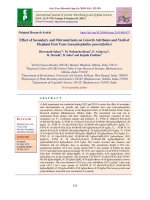
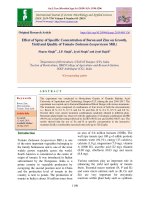
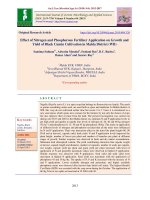
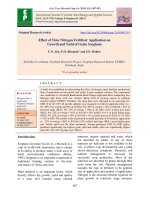
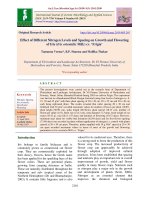

![Effect of precision farming techniques involving fertigation and mulching on growth attributes and seed yield of okra var. Arka Anamika [Abelmoschus esculentus (L.) Moench]](https://media.store123doc.com/images/document/2020_01/14/medium_ynr1578936108.jpg)


![Character association and path co-efficient analysis in F2 segregating population of Cross “Arka Kamini x PG Violet” in China Aster (Callistephus chinensis [L.] Nees)](https://media.store123doc.com/images/document/2020_01/14/medium_bzs1578961920.jpg)